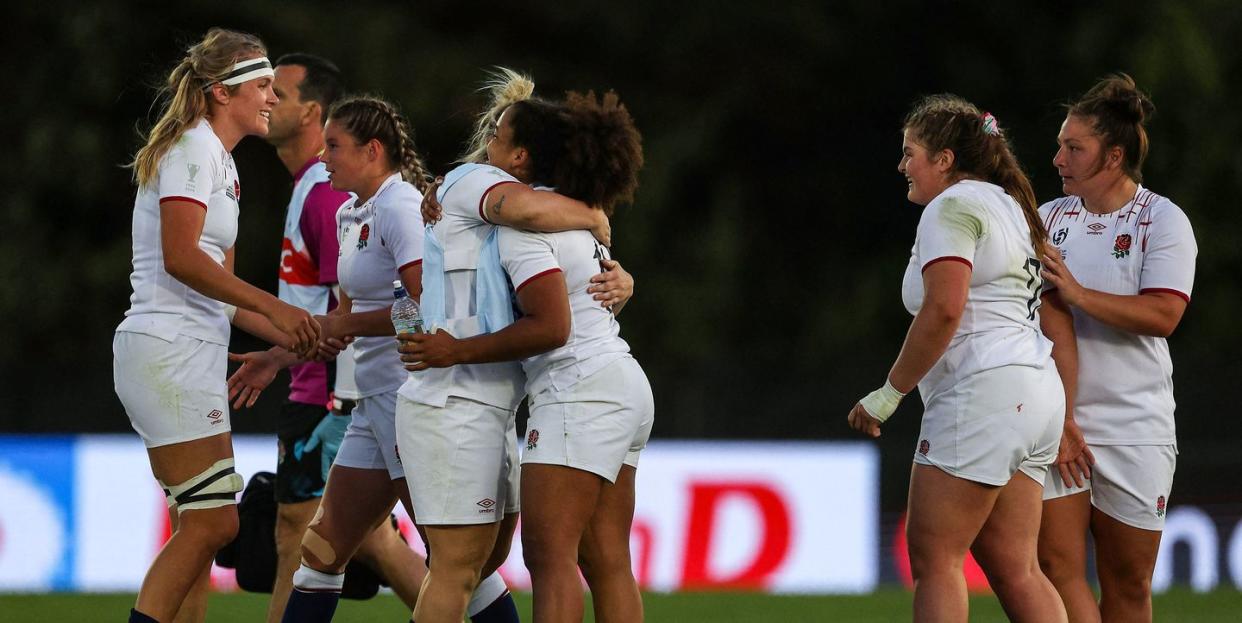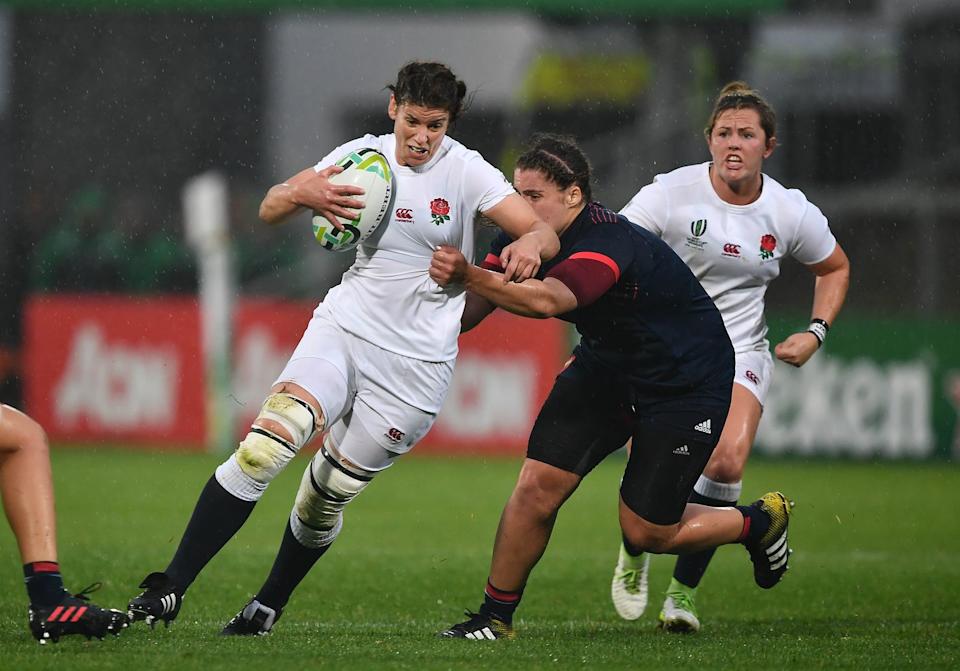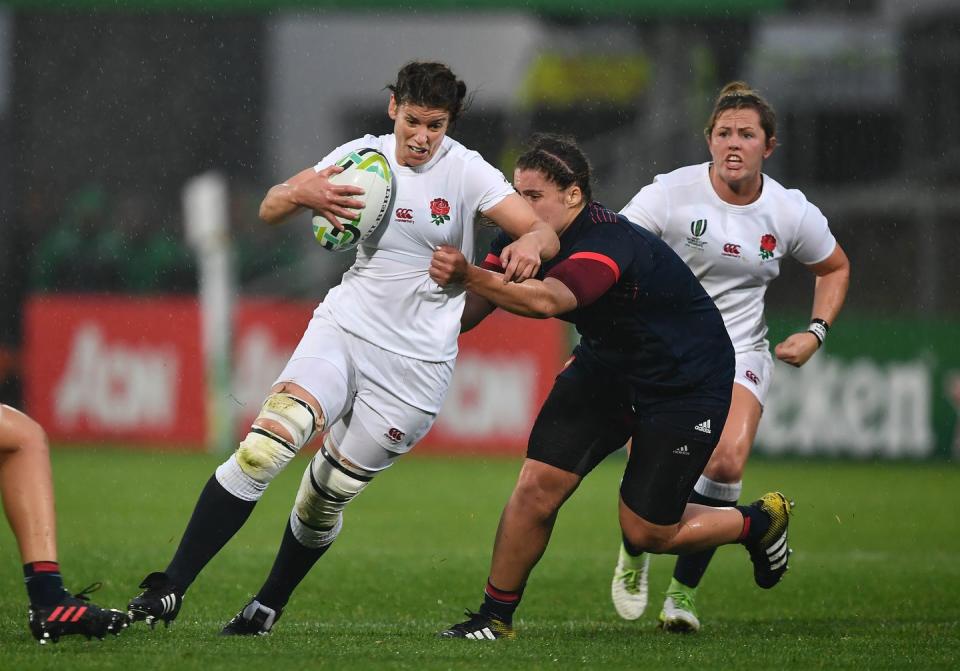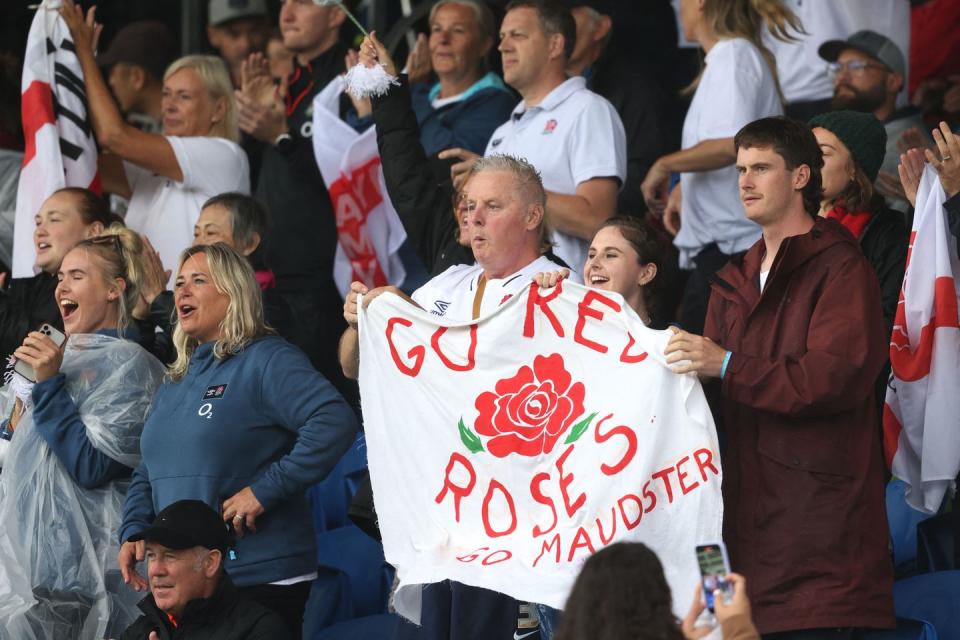How The Lionesses' Win Transformed Women’s Sport Ahead Of The Women’s Rugby World Cup

In the early hours of Saturday morning, UK viewers will watch the Red Roses step out to a roaring, sold-out crowd of over 40,000 fans at Eden Park in Auckland, New Zealand before they battle it out against the host country’s Black Ferns in the Women’s Rugby World Cup Final. It will be the biggest crowd any stadium has welcomed in the history of women’s rugby. The unprecedented level of demand for tickets follows the teams’ semi-final victories last week.
‘The girls put their bodies on the line and that's what it means to us, we were desperate to get to the final,’ said England Captain Sarah Hunter following her team’s outstanding victory against Canada last Saturday. That desperation has been the fuel behind the team’s unwavering success in the tournament so far this season. A drive not only to prove their sporting prowess above their competitors, but the validity of women in a sport that is so characterised by the activity of the opposite sex.
It’s been just over 30 years since the inaugural women’s World Cup, organised by four female volunteers with full-time jobs from Richmond Rugby Club and a shared love of the sport. The event – which lasted nine days – came to fruition without the backing of the Rugby Football Union or the International Rugby Board, as its creators were told that women’s rugby is a ‘participation sport not a spectator sport’.
Jenny Mitton, the director at M&C Saatchi Sports and Entertainment, is an advisor for the Girls Rugby Club and sits on the Rugby Football Union's Growth sub-committee. Far from the five-star treatment and champagne-filled hotel suites of many athletes today, she tells ELLE UK of the realities female players faced in the first rugby World Cup. ‘One night the England players were forced to sleep on the floor of a hotel conference room because the hotel had made a double booking. And the then USSR team funded their trip by selling suitcases of Russian dolls and vodka,’ she says.
Rachael Burford, a former English rugby union player and co-founder of the Girls Rugby Club, who is currently in New Zealand ahead of the final, admits that the early days of her career in the Noughties were a similar story. ‘We didn’t have any marketing or media coverage, we wore oversized kit and had to pay our own travel to get to matches… the list could go on,’ she reveals of the lack of support female players endured.
Fast forward to 2022, and the Rugby Football Union has forecasted that the 2025 women’s World Cup - which will be hosted in England – will provide a £156 million uplift to the UK economy, and result in a 82,000 sell-out crowd at the final, compared to the 3,000 crowd at the 1991 final. So much for women’s rugby being a ‘participation sport’...
But it’d be a Disney fairytale to suggest that this weekend is the crowning moment in a three decade-long mission to show the importance of women’s rugby to advertisers, investors, rugby unions, and fans. After all, there are still many hurdles Women’s Rugby faces when it comes to its professionalism and visibility on a global scale.

Despite women having played rugby for over a century, in 2019 England and France became the first and only countries to provide professional contracts for its women’s rugby union teams. A handful of countries have followed suit – only this year, we might add – with Wales announcing it was making 12 of its players fully professional, Scotland saying it would offer 36 professional contracts to their 15-a-side national squad players, and the Italian Rugby Federation revealing that it would offer 25 part-time annual contracts to its women’s rugby union team. ‘A lot of the women we're seeing on the pitch still go back to their day job,’ explains Mitton. ‘There are doctors, plumbers and electricians playing. We have made a huge jump forward, but we're certainly not in the same world of football just yet.’
Just 24 hours after England beat Ireland in the Women's Six Nations in April, Irish player Aoife McDermott sparked outrage from fans and fellow players alike after sharing a picture of herself back at work as a nurse. England's most-capped rugby international Rochelle ‘Rocky’ Clark called for the ‘ludicrous’ disparity between international players’ contracts to end, noting: ‘Women playing an international then straight back to work is ludicrous. They have to go pro to evolve. Teams need to be full-time athletes to be the best they can be.’
Back to it! 😴😴😴 pic.twitter.com/j3kv5oRrka
— Aoife McDermott (@AoifeMc15) April 25, 2022
This year also marked the first time the Women’s Six Nations had its own title partner in TikTok and a Women’s Six Nations segment on Sky Sports to broadcast the tournament. Despite this, the fact that players like Hunter recently broke the record to become the most capped England player – male and female – ever, and the fact that the same level of professionalism and performance is expected on and off the pitch from both sexes, in 2019 the average annual salary for a female rugby player was £24,000, which is almost what an England men’s player made for a single game that year, according to the Times. Progress in women's rugby has been made, but it's years away from its crescendo.
As Robert Kitson, the rugby union correspondent for the Guardian, put it, the Women’s Rugby World Cup ‘is a stepping stone rather than final destination’. In a recent article, he argued that only when England stages the 2025 world cup will we ‘truly see how rich the future for women’s rugby can be’. ‘The tournament is expanding to 16 teams, the exposure and sponsorship income will be substantially increased, and the next generational talents of this World Cup will be granted a significantly bigger stage,’ he adds.

Some part of the growing success of Women’s Rugby can be attributed to the Lionesses’ victory in the Women's Euro 2022 football tournament earlier this year. The attendance of 87,192 fans in Wembley Stadium was the largest for any Euros match - men’s or women’s - in history. A record-breaking 17.4 million people in the UK watched the team ‘bring football home’, making it the most-watched women’s football match ever and toppling the Queen's jubilee TV ratings. Today, England and Arsenal forward, Beth Mead – who was the runner-up in this year’s Ballon d'Or competition - received the BBC Women's Footballer of the Year Award 2022. Meanwhile, she several of her teammates are now rumoured to be poised for New Year’s Honours. ‘This team deserves every accolade, everything that can be bestowed upon them,’ said former England player Ian Wright of the speculation.
While a different sport entirely, those involved in rugby agree Lioness players like Mead have finally made people take women’s sport as a whole more seriously. ‘Often there's this perception of, “Isn't it great that women are playing sport. That's really nice. Great, go on girls! But the Lionesses showed the professionalism of women's sport, how exciting it can be, and that women's sport is the same as men's, it just involves the opposite sex,’ says Mitton.
Burford agrees. ‘The Lionesses changed the landscape,’ she says. ‘At a grassroots level their success will have a direct impact on the participation of women in sport. Their win has opened the eyes [of those with the power over] broadcast deals, sponsors activation and the people who were on the fence about investing in women's sport who can no longer see it as a gamble!’
But highlighting the triumphs of one women’s sporting team doesn’t automatically create actionable change when it comes to raising the profile of another, in this case Women’s Rugby. What’s required is heightened awareness of the commercial profitability of and appetite for the sport. In addition to additional investment, this means improving the visibility of the sport, according to Mitton, whether it’s ensuring rugby clubs and governing bodies cover men’s and women’s teams equally on their social media feeds, or giving women’s rugby games primetime TV slots in the same way as men’s, and not hiding them behind the red button.

‘Sadly, we still have to prove the worth of women's sport, and change the narrative that’s suggested that women's sports isn’t capable of doing what men’s sport can, in terms of attracting fans and commercial revenue. But we’re in a position now where the proof is there,’ says Burford, who credits the increase of the number of women in decision-making roles in the sport for helping to provide a stronger vision for the sport's future. Her immediate hope is for women’s international rugby to be professional (in terms of contracts) across all countries that compete at the elite level.
And while many people are quick qualify the success of women’s rugby by comparing it to men’s, Mitton says it’s important that supporters and players don't beat themselves up for not having yet achieved the same levels of success as men in the sport. ‘It took years for men’s rugby to develop, so it’ll be a similar for process for women, and that’s okay,’ she says. Women’s rugby might not have the same history of sponsorship and commercial deals that men’s sport has, but she believes this gives women’s teams the advantage of writing their own future. ‘We can be more modern in our approach and bring in new audiences,’ she adds. ‘If you go to a men's football or rugby match, you know what to expect. But with women’s sport, it’s relatively "new" for a lot of audiences, and that’s exciting.’
The final between England and New Zealand will take place on Saturday November 12 at 06:30 GMT.
You Might Also Like


